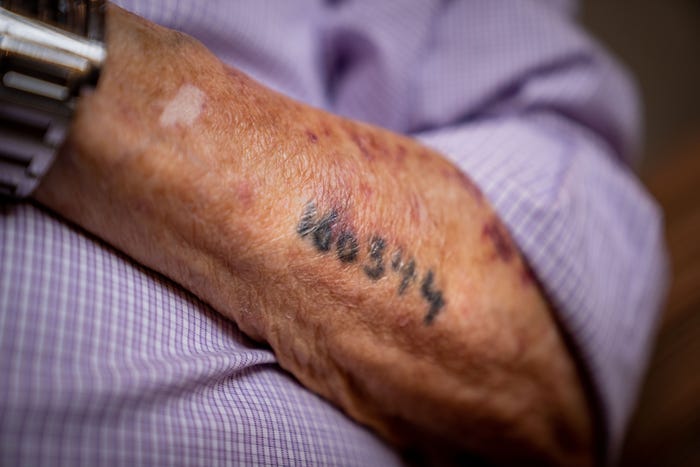
For many, the blurred blue lines of a serial number on a forearm are an indelible image of the Holocaust. The tattoos of the survivors have come to symbolize the utter brutality and of the concentration camps and the attempt of the Nazis to dehumanize their victims. The tattoos are also a testament to the resilience of those who bear them. Yet despite the importance of the tattoos, as testament, symbol, and historical artifact, little scholarship has been devoted to the subject. There exist virtually no official period documents relating to the practice; what we know stems from anecdotal evidence contained in camp records and the accounts of those who were at the camps.
The Auschwitz Concentration Camp Complex (including Auschwitz 1, AuschwitzBirkenau, and Monowitz) was the only location in which prisoners were systematically tattooed during the Holocaust. Prior to tattooing, several means of identifying prisoners, both by number and by category, had been implemented; serial numbers were the main method. When they arrived at the camp, prisoners were issued serial numbers which were then sewn to their prison uniforms. These serial numbers were most often accompanied by different shapes, symbols or letters which identified the status, nationality, or religion of the prisoner. This practice continued even after tattooing was introduced.
The sequence according to which serial numbers were issued evolved over time. The numbering scheme was divided into "regular," AU, Z, EH, A, and B series'. The "regular" series consisted of a consecutive numerical series that was used, in the early phase of the Auschwitz concentration camp, to identify Poles, Jews, and most other prisoners (all male). This series was used from May 1940-January 1945, although the population that it identified evolved over time. Following the introduction of other categories of prisoners into the camp, the numbering scheme became more complex. The "AU" series denoted Soviet prisoners of war, while the "Z" series (with the "Z" standing for the German word for Gypsy, Zigeuner) designated the Romany. These identifying letters preceded the tattooed serial numbers after they were instituted. "EH" designated prisoners that had been sent for "reeducation" (Erziehungshäftlinge). These prisoners had either refused to work at forced labor or had been accused of working in a manner that was not found satisfactory. They were sent to the concentration camps or to special "Labor Education Camps" (Arbeitserziehungslager) for a specified period of time not to exceed 56 days. Initially their serial numbers belonged to the regular series; in February 1942 a separate series was instituted for the EH category and their old registration numbers were reassigned.¹
Women were not issued numbers from the same series as the men. The first female prisoners arrived in March of 1942; they were issued numbers in a new "regular" series, just as the men had been. As the number of female prisoners brought to the camp escalated, new number series were started in the respective categories.
In May 1944, numbers in the "A" series and the "B" series were first issued to Jewish prisoners, beginning with the men on May 13th and the women on May 16th. The "A" series was to be completed with 20,000; however an error led to the women being numbered to 25,378 before the "B" series was begun. The intention was to work through the entire alphabet with 20,000 numbers being issued in each letter series. In each series, men and women had their own separate numerical series, ostensibly beginning with number 1.
There were, however, many exceptions to this rule and the extant information regarding serial numbers is but one of the tools for determining the number of prisoners that came through the Auschwitz camp complex. Prisoners selected for immediate extermination were virtually never issued numbers, and many Soviet prisoners of war and police prisoners (Polizeihäftlinge)* sent from the Myslowice prison due to overcrowding² were not registered.
It is generally accepted that the tattooing of prisoners began with the influx of Soviet prisoners of war into Auschwitz in 1941. Approximately 12,000 Soviet prisoners of war were brought to and registered in the Auschwitz concentration camp complex between 1941-1945; most arrived in October 1941 from Stalag 308 in Neuhammer. They retained their army uniforms, which were painted with a stripe and the letters SU (Soviet Union) in oil paint. In November, a special commission led by the head of the Kattowitz Gestapo, Dr. Rudolf Mildner, came to Auschwitz. Following the guidelines of an operational order of July 17, 1941, the Soviet prisonersofwar were divided into groups described as "fanatic Communist," "politically suspect," "not politically suspect" or "suitable for reeducation." After a month's work, the commission had singled out approximately 300 "fanatic Communists.³ Those designated as such were tattooed by means of a metal plate with interchangeable needles attached to it; the plate was impressed into the flesh on the left side of their chests and then dye was rubbed into the wound. The tattoo read AU (for Auschwitz) followed by a number. Other Soviet prisonersofwar had their Identification numbers written on their chests with indelible ink, but this wore off too quickly.4 Thus tattooing of most Soviet prisonersofwar was eventually implemented. Circumstantial evidence indicates that tattooing of prisoners was not systematically implemented in Auschwitz in 1941.
On November 11, 1941, the Polish national holiday, the camp authorities executed 151 prisoners in Auschwitz. Prior to execution, the prisoner's number was written on either his chest (if he were to be shot at close range) or his leg (if he were to be shot by firing squad). The socalled camp infirmary had also adopted the practice of writing a prisoner's number on his chest.5
As the number of prisoners brought to the expanding Auschwitz complex rose, so did the death rate. But if a corpse were separated from its uniform, identification was rendered all but impossible. With often hundreds of prisoners dying per day, other methods of identification were needed. In Birkenau, the method used to tattoo the Soviet prisoners of war was implemented for emaciated prisoners whose deaths were imminent; the tattoos were later made with pen and ink on the upper left forearm. By 1942, Jews had become the predominant group represented at Auschwitz. They were tattooed based on numbers in the regular series until 1944; their numbers were preceded by a triangle, most likely to identify them as Jews.
By spring of 1943 most of the prisoners were being tattooed, even those who had been registered previously. There were, however, notable exceptions. Ethnic Germans, reeducation prisoners, police prisoners, and inmates selected for immediate extermination were not tattooed.
While it cannot be determined with absolute certainty, it seems that tattooing was implemented mainly for ease of identification whether in the case of death or escape; the practice continued until the last days of Auschwitz.
Sources: Center for Holocaust and Genocide Studies
*Polizeihäftlinge is a general term that may be used to indicate anyone arrested by the Gestapo. These prisoners may have been socalled career criminals (Befristeter Vorbeugungshäftlinge, also known in camp jargon as Berufsverbrecher), protective prisoners (Schutzhäfilinge), or reeducation prisoners (Erziehungshäftlinge).
¹Piper, Franciszek and Teresa ¥wiebocka, eds. (trans. Douglas Selvage), Auschwitz Nazi Death Camp (O¥wiecim The AuschwitzBirkenau State Museum in Oswiecim, 1996), p. 62.
²lbid ., p. 66.
³Czech, Danuta, Auschwitz Chronicle 19391945 (New York: Henry Holt and Co., 1990), p. 102.
4Klarsfeld, Serge, ed., Les matricules tatoues des camps d'AuschwitzBirkenau (Beate Klarsfeld Foundation), p. 27.
5Council for the Protection of Monuments of Struggle and Martyrdom (trans. lain W. M. Taylor), Auschwitz: Nazi Extermination Camp (Warsaw: Interpress, 1985), p. 54
.
Such was the storied Nazi tattoos used to identify “the vermin” in the extermination camps of Auschwitz. Now, here in the Land of the Brave and the Home of the Free, serial numbers are again being threatened — by none other than a former president and a current presidential candidate with a damn good chance of winning and becoming our own little dictator. It isn’t Jews he has promised to issue serial numbers, although with his recent rhetoric aimed at American Jews who won’t vote for him, that may be on his mind. But not yet. Right now he wants to serialize immigrants who have crossed out southern border, and then deporting them.
Ellie Quinlan Houghtaling, writing for The New Republic, said “Immigrants are no longer welcome in Donald Trump’s America. Instead, the Republican presidential nominee posited that under his potential second administration, he would round up and mass-deport noncitizens based on their ‘serial numbers.’”
“But we’re getting the criminals out, and we’re going to do that fast, and we know who they are, and the local police know their names, and they know their serial numbers,” Drumpf said. “They know everything about them.”
Drumpf has regularly mimicked Adolf Hitler during his campaign. But the mention of serial numbers — a terrifying echo of the identification numbers forcibly tattooed on concentration camp prisoners — is one of his most chilling references yet.
“We’re not a dumping ground,” Drumpf continued. “We’re going to get all of those people out, and we’re going to get them out fast.”
Fortunate for the immigrants, “they” don’t actually know who “they” are, and “they” (immigrants) don’t currently have serial numbers.
Attkisson asked Drumpf, “A lot of the millions of people have had children who are American citizens, and don’t you think the first time there is an image on television of a family tearfully being told to board a bus that that whole program would end?”
His response? An unconstitutional First Amendment violation, of course. Our constitution means nothing to him.
So, what would he do? He would silence the media. “That’s right,” he said. “If you take a young woman with two beautiful children, and you put her on a bus, and it ends up on the front page of every newspaper. It makes it a lot harder.
“You put one wrong person onto a bus or onto an airplane, and your radical left lunatics will try and make it sound like the worst thing that’s ever happened,” he added.
So, if the bigots win in November, it will be “welcome to the United States of AmeriKKKa. Now get off of our lawn.”
Seig Heil Mein Führer!






